Financial Decision Making Report: John Lewis Company Analysis & Ratios
VerifiedAdded on 2021/02/21
|11
|3679
|92
Report
AI Summary
This report delves into the realm of financial decision-making, emphasizing the crucial role of accounting and finance within organizations. It begins with an introduction to financial decision-making as a strategic process, focusing on the allocation of financial resources. The report uses John Lewis as a case study, a UK-based company. The main body explores the significance of accounting and finance, highlighting various management accounting techniques such as standard costing, budgetary control, and financial statement analysis. The report then examines the importance of these techniques, including their roles in performance assessment, planning, controlling, and decision-making. The report includes the calculation and interpretation of key financial ratios, such as Return on Capital Employed (ROCE), Net Profit Margin, Current Ratio, Debtor Collection Period, and Creditor Collection Period, for John Lewis over two years. The analysis reveals trends in the company's financial performance, providing insights into profitability, efficiency, and liquidity. The conclusion summarizes the key findings, emphasizing the importance of financial management in achieving organizational goals. References are also included.

FINANCIAL
DECISION MAKING
DECISION MAKING
Paraphrase This Document
Need a fresh take? Get an instant paraphrase of this document with our AI Paraphraser
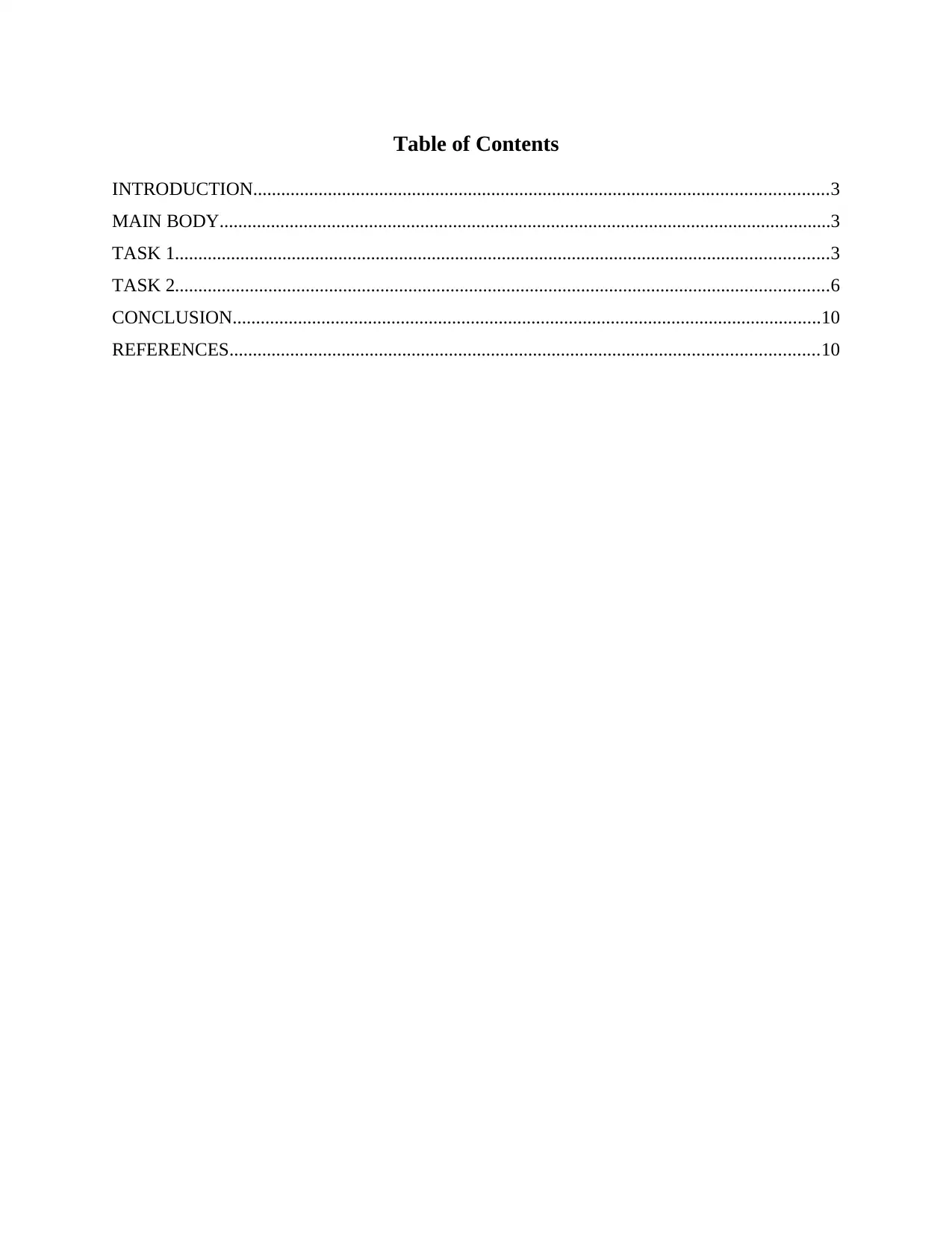
Table of Contents
INTRODUCTION...........................................................................................................................3
MAIN BODY...................................................................................................................................3
TASK 1............................................................................................................................................3
TASK 2............................................................................................................................................6
CONCLUSION..............................................................................................................................10
REFERENCES..............................................................................................................................10
INTRODUCTION...........................................................................................................................3
MAIN BODY...................................................................................................................................3
TASK 1............................................................................................................................................3
TASK 2............................................................................................................................................6
CONCLUSION..............................................................................................................................10
REFERENCES..............................................................................................................................10
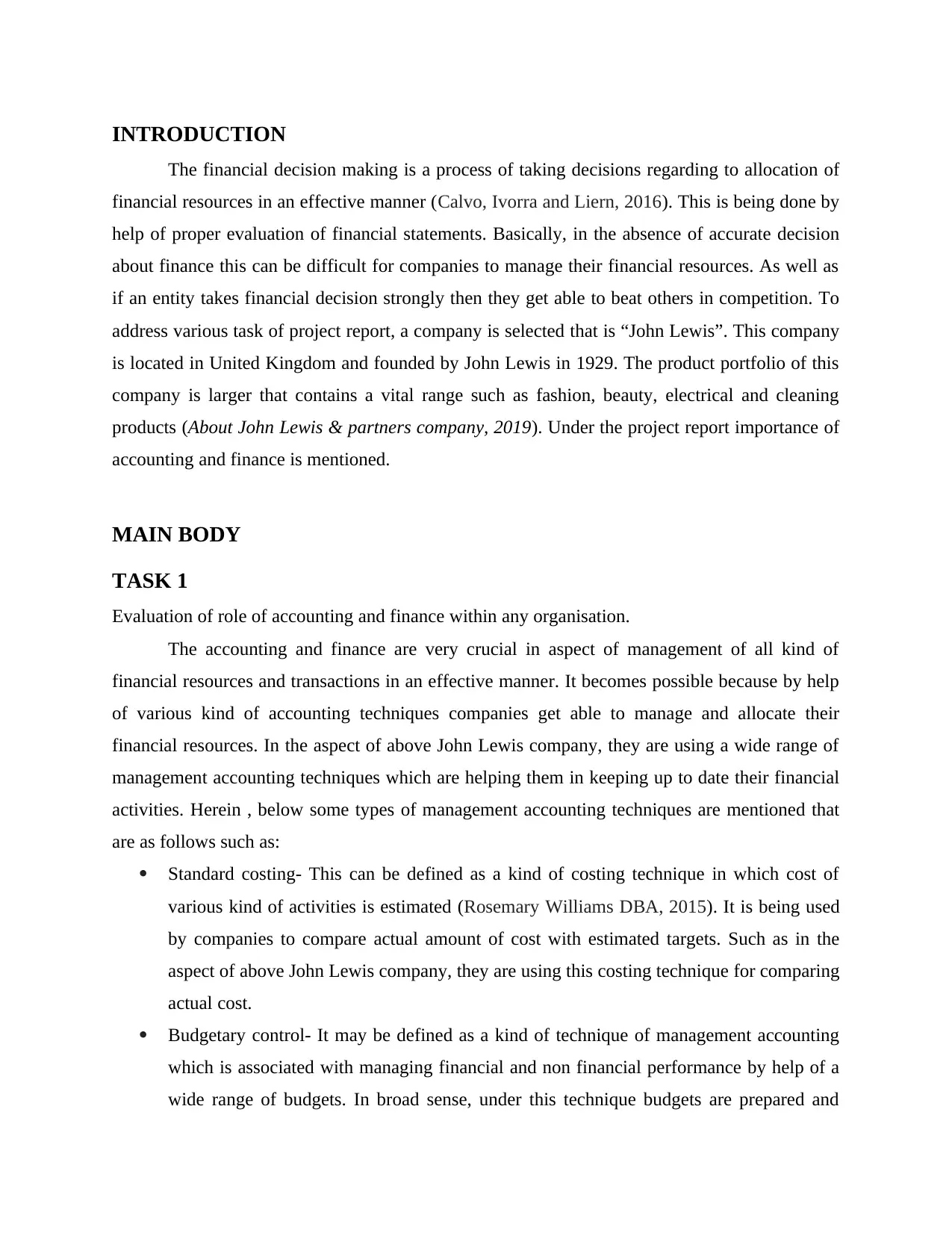
INTRODUCTION
The financial decision making is a process of taking decisions regarding to allocation of
financial resources in an effective manner (Calvo, Ivorra and Liern, 2016). This is being done by
help of proper evaluation of financial statements. Basically, in the absence of accurate decision
about finance this can be difficult for companies to manage their financial resources. As well as
if an entity takes financial decision strongly then they get able to beat others in competition. To
address various task of project report, a company is selected that is “John Lewis”. This company
is located in United Kingdom and founded by John Lewis in 1929. The product portfolio of this
company is larger that contains a vital range such as fashion, beauty, electrical and cleaning
products (About John Lewis & partners company, 2019). Under the project report importance of
accounting and finance is mentioned.
MAIN BODY
TASK 1
Evaluation of role of accounting and finance within any organisation.
The accounting and finance are very crucial in aspect of management of all kind of
financial resources and transactions in an effective manner. It becomes possible because by help
of various kind of accounting techniques companies get able to manage and allocate their
financial resources. In the aspect of above John Lewis company, they are using a wide range of
management accounting techniques which are helping them in keeping up to date their financial
activities. Herein , below some types of management accounting techniques are mentioned that
are as follows such as:
Standard costing- This can be defined as a kind of costing technique in which cost of
various kind of activities is estimated (Rosemary Williams DBA, 2015). It is being used
by companies to compare actual amount of cost with estimated targets. Such as in the
aspect of above John Lewis company, they are using this costing technique for comparing
actual cost.
Budgetary control- It may be defined as a kind of technique of management accounting
which is associated with managing financial and non financial performance by help of a
wide range of budgets. In broad sense, under this technique budgets are prepared and
The financial decision making is a process of taking decisions regarding to allocation of
financial resources in an effective manner (Calvo, Ivorra and Liern, 2016). This is being done by
help of proper evaluation of financial statements. Basically, in the absence of accurate decision
about finance this can be difficult for companies to manage their financial resources. As well as
if an entity takes financial decision strongly then they get able to beat others in competition. To
address various task of project report, a company is selected that is “John Lewis”. This company
is located in United Kingdom and founded by John Lewis in 1929. The product portfolio of this
company is larger that contains a vital range such as fashion, beauty, electrical and cleaning
products (About John Lewis & partners company, 2019). Under the project report importance of
accounting and finance is mentioned.
MAIN BODY
TASK 1
Evaluation of role of accounting and finance within any organisation.
The accounting and finance are very crucial in aspect of management of all kind of
financial resources and transactions in an effective manner. It becomes possible because by help
of various kind of accounting techniques companies get able to manage and allocate their
financial resources. In the aspect of above John Lewis company, they are using a wide range of
management accounting techniques which are helping them in keeping up to date their financial
activities. Herein , below some types of management accounting techniques are mentioned that
are as follows such as:
Standard costing- This can be defined as a kind of costing technique in which cost of
various kind of activities is estimated (Rosemary Williams DBA, 2015). It is being used
by companies to compare actual amount of cost with estimated targets. Such as in the
aspect of above John Lewis company, they are using this costing technique for comparing
actual cost.
Budgetary control- It may be defined as a kind of technique of management accounting
which is associated with managing financial and non financial performance by help of a
wide range of budgets. In broad sense, under this technique budgets are prepared and
⊘ This is a preview!⊘
Do you want full access?
Subscribe today to unlock all pages.

Trusted by 1+ million students worldwide
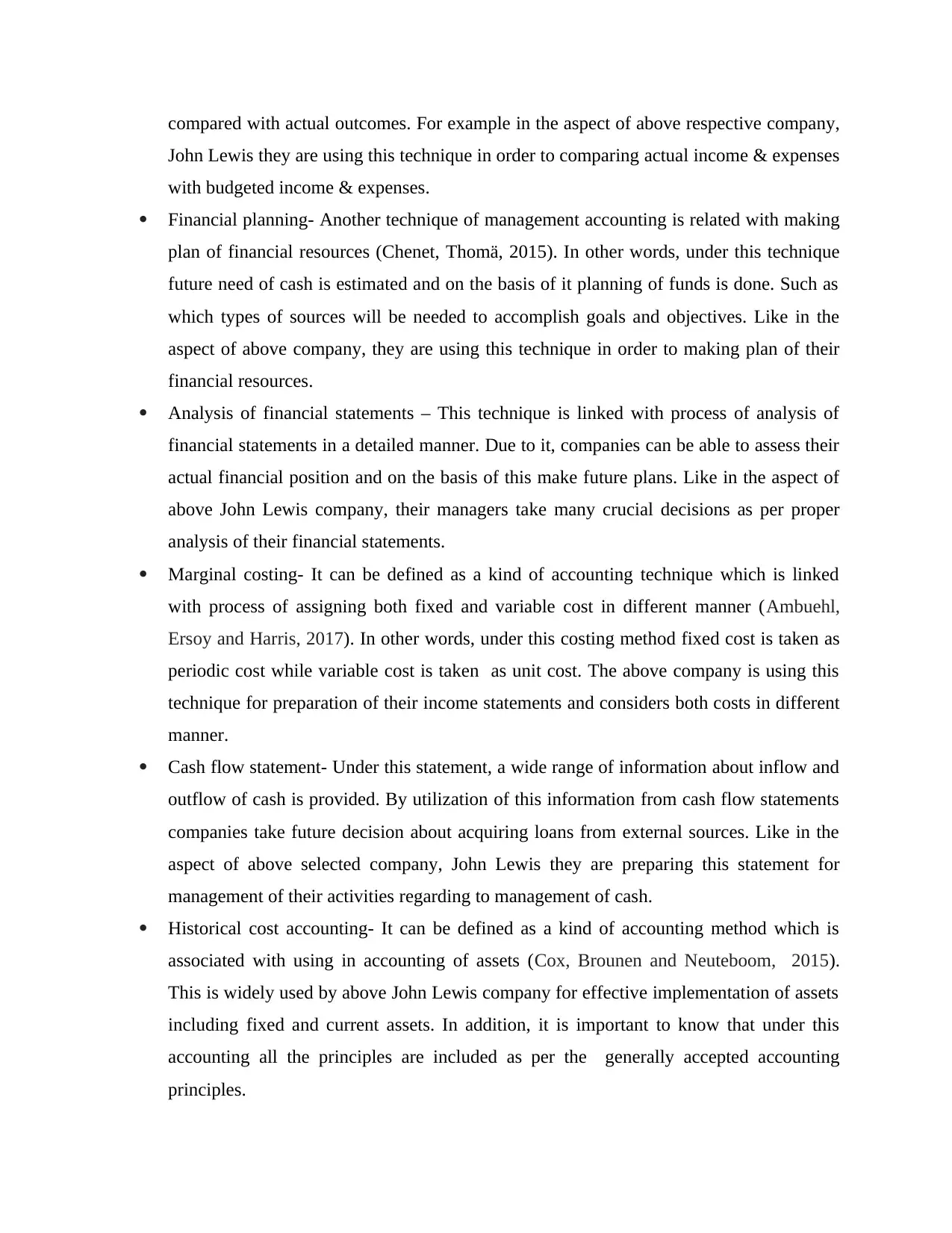
compared with actual outcomes. For example in the aspect of above respective company,
John Lewis they are using this technique in order to comparing actual income & expenses
with budgeted income & expenses.
Financial planning- Another technique of management accounting is related with making
plan of financial resources (Chenet, Thomä, 2015). In other words, under this technique
future need of cash is estimated and on the basis of it planning of funds is done. Such as
which types of sources will be needed to accomplish goals and objectives. Like in the
aspect of above company, they are using this technique in order to making plan of their
financial resources.
Analysis of financial statements – This technique is linked with process of analysis of
financial statements in a detailed manner. Due to it, companies can be able to assess their
actual financial position and on the basis of this make future plans. Like in the aspect of
above John Lewis company, their managers take many crucial decisions as per proper
analysis of their financial statements.
Marginal costing- It can be defined as a kind of accounting technique which is linked
with process of assigning both fixed and variable cost in different manner (Ambuehl,
Ersoy and Harris, 2017). In other words, under this costing method fixed cost is taken as
periodic cost while variable cost is taken as unit cost. The above company is using this
technique for preparation of their income statements and considers both costs in different
manner.
Cash flow statement- Under this statement, a wide range of information about inflow and
outflow of cash is provided. By utilization of this information from cash flow statements
companies take future decision about acquiring loans from external sources. Like in the
aspect of above selected company, John Lewis they are preparing this statement for
management of their activities regarding to management of cash.
Historical cost accounting- It can be defined as a kind of accounting method which is
associated with using in accounting of assets (Cox, Brounen and Neuteboom, 2015).
This is widely used by above John Lewis company for effective implementation of assets
including fixed and current assets. In addition, it is important to know that under this
accounting all the principles are included as per the generally accepted accounting
principles.
John Lewis they are using this technique in order to comparing actual income & expenses
with budgeted income & expenses.
Financial planning- Another technique of management accounting is related with making
plan of financial resources (Chenet, Thomä, 2015). In other words, under this technique
future need of cash is estimated and on the basis of it planning of funds is done. Such as
which types of sources will be needed to accomplish goals and objectives. Like in the
aspect of above company, they are using this technique in order to making plan of their
financial resources.
Analysis of financial statements – This technique is linked with process of analysis of
financial statements in a detailed manner. Due to it, companies can be able to assess their
actual financial position and on the basis of this make future plans. Like in the aspect of
above John Lewis company, their managers take many crucial decisions as per proper
analysis of their financial statements.
Marginal costing- It can be defined as a kind of accounting technique which is linked
with process of assigning both fixed and variable cost in different manner (Ambuehl,
Ersoy and Harris, 2017). In other words, under this costing method fixed cost is taken as
periodic cost while variable cost is taken as unit cost. The above company is using this
technique for preparation of their income statements and considers both costs in different
manner.
Cash flow statement- Under this statement, a wide range of information about inflow and
outflow of cash is provided. By utilization of this information from cash flow statements
companies take future decision about acquiring loans from external sources. Like in the
aspect of above selected company, John Lewis they are preparing this statement for
management of their activities regarding to management of cash.
Historical cost accounting- It can be defined as a kind of accounting method which is
associated with using in accounting of assets (Cox, Brounen and Neuteboom, 2015).
This is widely used by above John Lewis company for effective implementation of assets
including fixed and current assets. In addition, it is important to know that under this
accounting all the principles are included as per the generally accepted accounting
principles.
Paraphrase This Document
Need a fresh take? Get an instant paraphrase of this document with our AI Paraphraser
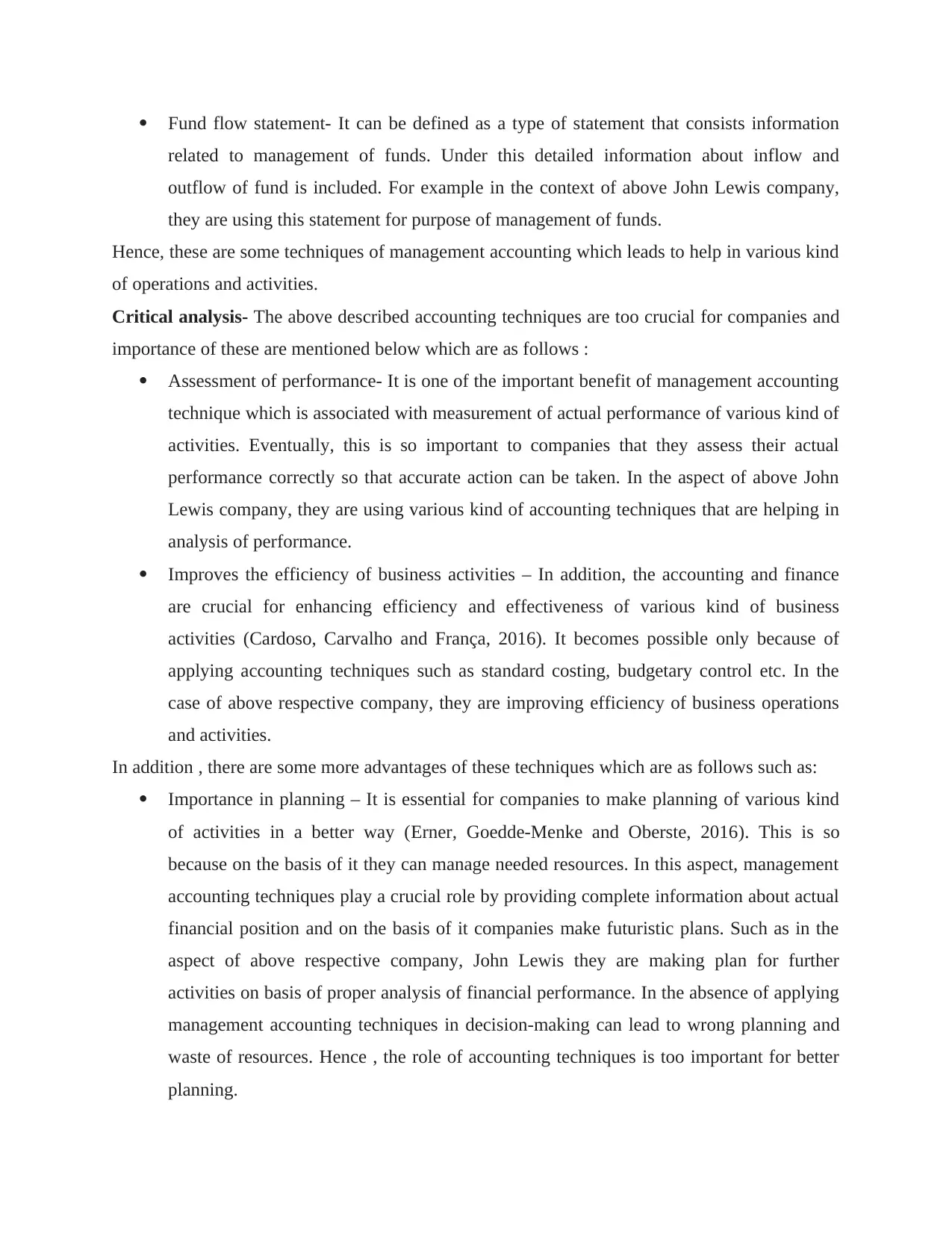
Fund flow statement- It can be defined as a type of statement that consists information
related to management of funds. Under this detailed information about inflow and
outflow of fund is included. For example in the context of above John Lewis company,
they are using this statement for purpose of management of funds.
Hence, these are some techniques of management accounting which leads to help in various kind
of operations and activities.
Critical analysis- The above described accounting techniques are too crucial for companies and
importance of these are mentioned below which are as follows :
Assessment of performance- It is one of the important benefit of management accounting
technique which is associated with measurement of actual performance of various kind of
activities. Eventually, this is so important to companies that they assess their actual
performance correctly so that accurate action can be taken. In the aspect of above John
Lewis company, they are using various kind of accounting techniques that are helping in
analysis of performance.
Improves the efficiency of business activities – In addition, the accounting and finance
are crucial for enhancing efficiency and effectiveness of various kind of business
activities (Cardoso, Carvalho and França, 2016). It becomes possible only because of
applying accounting techniques such as standard costing, budgetary control etc. In the
case of above respective company, they are improving efficiency of business operations
and activities.
In addition , there are some more advantages of these techniques which are as follows such as:
Importance in planning – It is essential for companies to make planning of various kind
of activities in a better way (Erner, Goedde-Menke and Oberste, 2016). This is so
because on the basis of it they can manage needed resources. In this aspect, management
accounting techniques play a crucial role by providing complete information about actual
financial position and on the basis of it companies make futuristic plans. Such as in the
aspect of above respective company, John Lewis they are making plan for further
activities on basis of proper analysis of financial performance. In the absence of applying
management accounting techniques in decision-making can lead to wrong planning and
waste of resources. Hence , the role of accounting techniques is too important for better
planning.
related to management of funds. Under this detailed information about inflow and
outflow of fund is included. For example in the context of above John Lewis company,
they are using this statement for purpose of management of funds.
Hence, these are some techniques of management accounting which leads to help in various kind
of operations and activities.
Critical analysis- The above described accounting techniques are too crucial for companies and
importance of these are mentioned below which are as follows :
Assessment of performance- It is one of the important benefit of management accounting
technique which is associated with measurement of actual performance of various kind of
activities. Eventually, this is so important to companies that they assess their actual
performance correctly so that accurate action can be taken. In the aspect of above John
Lewis company, they are using various kind of accounting techniques that are helping in
analysis of performance.
Improves the efficiency of business activities – In addition, the accounting and finance
are crucial for enhancing efficiency and effectiveness of various kind of business
activities (Cardoso, Carvalho and França, 2016). It becomes possible only because of
applying accounting techniques such as standard costing, budgetary control etc. In the
case of above respective company, they are improving efficiency of business operations
and activities.
In addition , there are some more advantages of these techniques which are as follows such as:
Importance in planning – It is essential for companies to make planning of various kind
of activities in a better way (Erner, Goedde-Menke and Oberste, 2016). This is so
because on the basis of it they can manage needed resources. In this aspect, management
accounting techniques play a crucial role by providing complete information about actual
financial position and on the basis of it companies make futuristic plans. Such as in the
aspect of above respective company, John Lewis they are making plan for further
activities on basis of proper analysis of financial performance. In the absence of applying
management accounting techniques in decision-making can lead to wrong planning and
waste of resources. Hence , the role of accounting techniques is too important for better
planning.
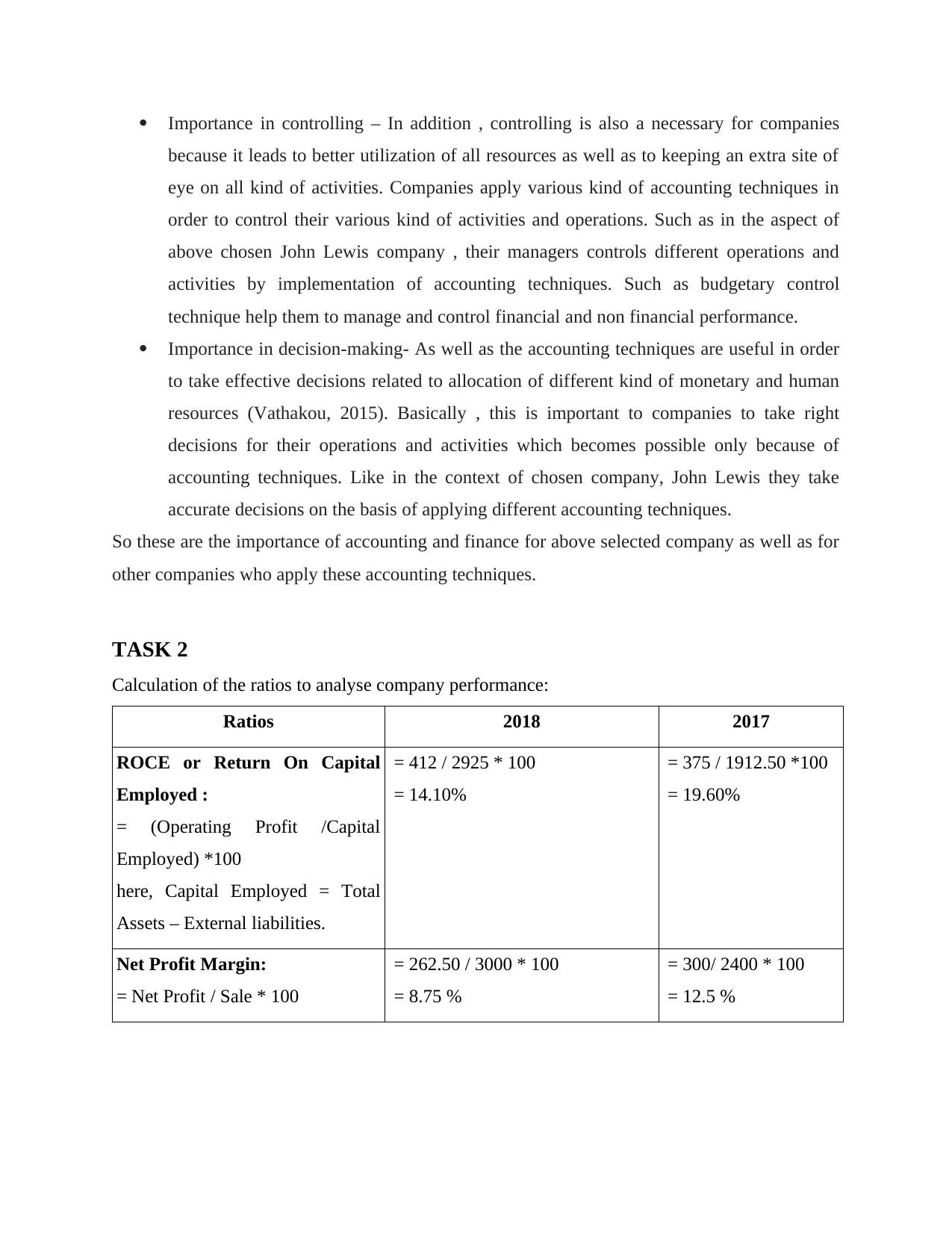
Importance in controlling – In addition , controlling is also a necessary for companies
because it leads to better utilization of all resources as well as to keeping an extra site of
eye on all kind of activities. Companies apply various kind of accounting techniques in
order to control their various kind of activities and operations. Such as in the aspect of
above chosen John Lewis company , their managers controls different operations and
activities by implementation of accounting techniques. Such as budgetary control
technique help them to manage and control financial and non financial performance.
Importance in decision-making- As well as the accounting techniques are useful in order
to take effective decisions related to allocation of different kind of monetary and human
resources (Vathakou, 2015). Basically , this is important to companies to take right
decisions for their operations and activities which becomes possible only because of
accounting techniques. Like in the context of chosen company, John Lewis they take
accurate decisions on the basis of applying different accounting techniques.
So these are the importance of accounting and finance for above selected company as well as for
other companies who apply these accounting techniques.
TASK 2
Calculation of the ratios to analyse company performance:
Ratios 2018 2017
ROCE or Return On Capital
Employed :
= (Operating Profit /Capital
Employed) *100
here, Capital Employed = Total
Assets – External liabilities.
= 412 / 2925 * 100
= 14.10%
= 375 / 1912.50 *100
= 19.60%
Net Profit Margin:
= Net Profit / Sale * 100
= 262.50 / 3000 * 100
= 8.75 %
= 300/ 2400 * 100
= 12.5 %
because it leads to better utilization of all resources as well as to keeping an extra site of
eye on all kind of activities. Companies apply various kind of accounting techniques in
order to control their various kind of activities and operations. Such as in the aspect of
above chosen John Lewis company , their managers controls different operations and
activities by implementation of accounting techniques. Such as budgetary control
technique help them to manage and control financial and non financial performance.
Importance in decision-making- As well as the accounting techniques are useful in order
to take effective decisions related to allocation of different kind of monetary and human
resources (Vathakou, 2015). Basically , this is important to companies to take right
decisions for their operations and activities which becomes possible only because of
accounting techniques. Like in the context of chosen company, John Lewis they take
accurate decisions on the basis of applying different accounting techniques.
So these are the importance of accounting and finance for above selected company as well as for
other companies who apply these accounting techniques.
TASK 2
Calculation of the ratios to analyse company performance:
Ratios 2018 2017
ROCE or Return On Capital
Employed :
= (Operating Profit /Capital
Employed) *100
here, Capital Employed = Total
Assets – External liabilities.
= 412 / 2925 * 100
= 14.10%
= 375 / 1912.50 *100
= 19.60%
Net Profit Margin:
= Net Profit / Sale * 100
= 262.50 / 3000 * 100
= 8.75 %
= 300/ 2400 * 100
= 12.5 %
⊘ This is a preview!⊘
Do you want full access?
Subscribe today to unlock all pages.

Trusted by 1+ million students worldwide
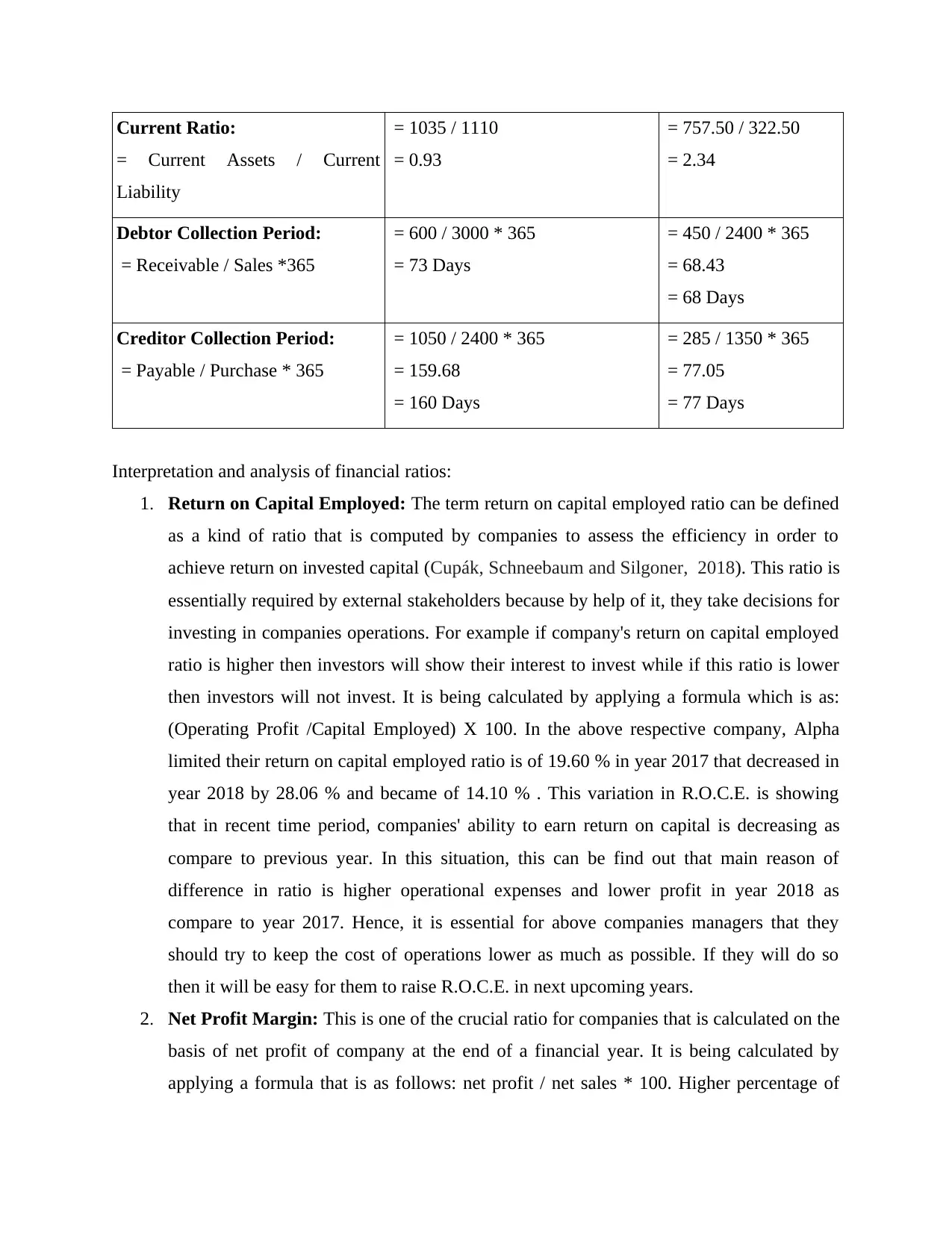
Current Ratio:
= Current Assets / Current
Liability
= 1035 / 1110
= 0.93
= 757.50 / 322.50
= 2.34
Debtor Collection Period:
= Receivable / Sales *365
= 600 / 3000 * 365
= 73 Days
= 450 / 2400 * 365
= 68.43
= 68 Days
Creditor Collection Period:
= Payable / Purchase * 365
= 1050 / 2400 * 365
= 159.68
= 160 Days
= 285 / 1350 * 365
= 77.05
= 77 Days
Interpretation and analysis of financial ratios:
1. Return on Capital Employed: The term return on capital employed ratio can be defined
as a kind of ratio that is computed by companies to assess the efficiency in order to
achieve return on invested capital (Cupák, Schneebaum and Silgoner, 2018). This ratio is
essentially required by external stakeholders because by help of it, they take decisions for
investing in companies operations. For example if company's return on capital employed
ratio is higher then investors will show their interest to invest while if this ratio is lower
then investors will not invest. It is being calculated by applying a formula which is as:
(Operating Profit /Capital Employed) X 100. In the above respective company, Alpha
limited their return on capital employed ratio is of 19.60 % in year 2017 that decreased in
year 2018 by 28.06 % and became of 14.10 % . This variation in R.O.C.E. is showing
that in recent time period, companies' ability to earn return on capital is decreasing as
compare to previous year. In this situation, this can be find out that main reason of
difference in ratio is higher operational expenses and lower profit in year 2018 as
compare to year 2017. Hence, it is essential for above companies managers that they
should try to keep the cost of operations lower as much as possible. If they will do so
then it will be easy for them to raise R.O.C.E. in next upcoming years.
2. Net Profit Margin: This is one of the crucial ratio for companies that is calculated on the
basis of net profit of company at the end of a financial year. It is being calculated by
applying a formula that is as follows: net profit / net sales * 100. Higher percentage of
= Current Assets / Current
Liability
= 1035 / 1110
= 0.93
= 757.50 / 322.50
= 2.34
Debtor Collection Period:
= Receivable / Sales *365
= 600 / 3000 * 365
= 73 Days
= 450 / 2400 * 365
= 68.43
= 68 Days
Creditor Collection Period:
= Payable / Purchase * 365
= 1050 / 2400 * 365
= 159.68
= 160 Days
= 285 / 1350 * 365
= 77.05
= 77 Days
Interpretation and analysis of financial ratios:
1. Return on Capital Employed: The term return on capital employed ratio can be defined
as a kind of ratio that is computed by companies to assess the efficiency in order to
achieve return on invested capital (Cupák, Schneebaum and Silgoner, 2018). This ratio is
essentially required by external stakeholders because by help of it, they take decisions for
investing in companies operations. For example if company's return on capital employed
ratio is higher then investors will show their interest to invest while if this ratio is lower
then investors will not invest. It is being calculated by applying a formula which is as:
(Operating Profit /Capital Employed) X 100. In the above respective company, Alpha
limited their return on capital employed ratio is of 19.60 % in year 2017 that decreased in
year 2018 by 28.06 % and became of 14.10 % . This variation in R.O.C.E. is showing
that in recent time period, companies' ability to earn return on capital is decreasing as
compare to previous year. In this situation, this can be find out that main reason of
difference in ratio is higher operational expenses and lower profit in year 2018 as
compare to year 2017. Hence, it is essential for above companies managers that they
should try to keep the cost of operations lower as much as possible. If they will do so
then it will be easy for them to raise R.O.C.E. in next upcoming years.
2. Net Profit Margin: This is one of the crucial ratio for companies that is calculated on the
basis of net profit of company at the end of a financial year. It is being calculated by
applying a formula that is as follows: net profit / net sales * 100. Higher percentage of
Paraphrase This Document
Need a fresh take? Get an instant paraphrase of this document with our AI Paraphraser
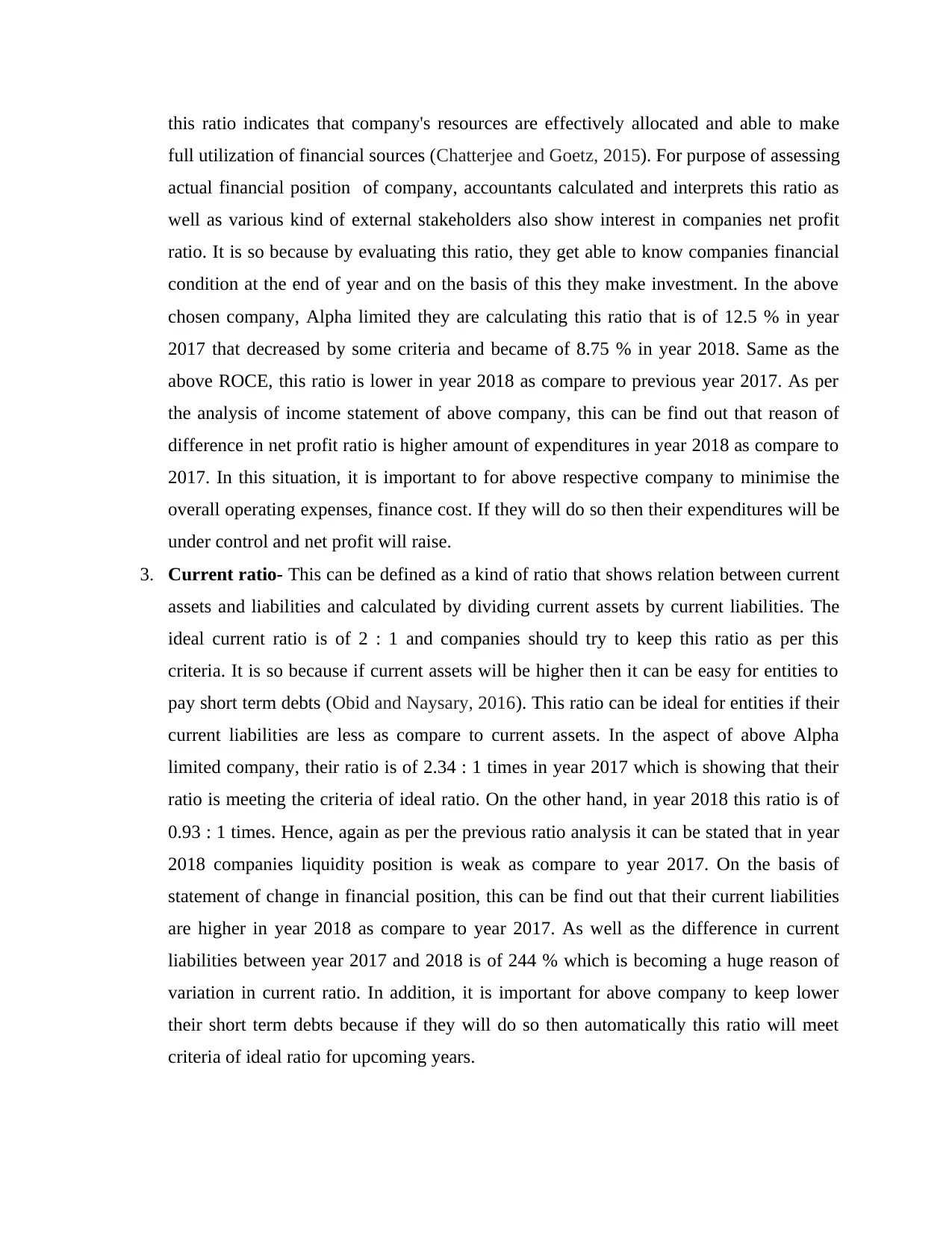
this ratio indicates that company's resources are effectively allocated and able to make
full utilization of financial sources (Chatterjee and Goetz, 2015). For purpose of assessing
actual financial position of company, accountants calculated and interprets this ratio as
well as various kind of external stakeholders also show interest in companies net profit
ratio. It is so because by evaluating this ratio, they get able to know companies financial
condition at the end of year and on the basis of this they make investment. In the above
chosen company, Alpha limited they are calculating this ratio that is of 12.5 % in year
2017 that decreased by some criteria and became of 8.75 % in year 2018. Same as the
above ROCE, this ratio is lower in year 2018 as compare to previous year 2017. As per
the analysis of income statement of above company, this can be find out that reason of
difference in net profit ratio is higher amount of expenditures in year 2018 as compare to
2017. In this situation, it is important to for above respective company to minimise the
overall operating expenses, finance cost. If they will do so then their expenditures will be
under control and net profit will raise.
3. Current ratio- This can be defined as a kind of ratio that shows relation between current
assets and liabilities and calculated by dividing current assets by current liabilities. The
ideal current ratio is of 2 : 1 and companies should try to keep this ratio as per this
criteria. It is so because if current assets will be higher then it can be easy for entities to
pay short term debts (Obid and Naysary, 2016). This ratio can be ideal for entities if their
current liabilities are less as compare to current assets. In the aspect of above Alpha
limited company, their ratio is of 2.34 : 1 times in year 2017 which is showing that their
ratio is meeting the criteria of ideal ratio. On the other hand, in year 2018 this ratio is of
0.93 : 1 times. Hence, again as per the previous ratio analysis it can be stated that in year
2018 companies liquidity position is weak as compare to year 2017. On the basis of
statement of change in financial position, this can be find out that their current liabilities
are higher in year 2018 as compare to year 2017. As well as the difference in current
liabilities between year 2017 and 2018 is of 244 % which is becoming a huge reason of
variation in current ratio. In addition, it is important for above company to keep lower
their short term debts because if they will do so then automatically this ratio will meet
criteria of ideal ratio for upcoming years.
full utilization of financial sources (Chatterjee and Goetz, 2015). For purpose of assessing
actual financial position of company, accountants calculated and interprets this ratio as
well as various kind of external stakeholders also show interest in companies net profit
ratio. It is so because by evaluating this ratio, they get able to know companies financial
condition at the end of year and on the basis of this they make investment. In the above
chosen company, Alpha limited they are calculating this ratio that is of 12.5 % in year
2017 that decreased by some criteria and became of 8.75 % in year 2018. Same as the
above ROCE, this ratio is lower in year 2018 as compare to previous year 2017. As per
the analysis of income statement of above company, this can be find out that reason of
difference in net profit ratio is higher amount of expenditures in year 2018 as compare to
2017. In this situation, it is important to for above respective company to minimise the
overall operating expenses, finance cost. If they will do so then their expenditures will be
under control and net profit will raise.
3. Current ratio- This can be defined as a kind of ratio that shows relation between current
assets and liabilities and calculated by dividing current assets by current liabilities. The
ideal current ratio is of 2 : 1 and companies should try to keep this ratio as per this
criteria. It is so because if current assets will be higher then it can be easy for entities to
pay short term debts (Obid and Naysary, 2016). This ratio can be ideal for entities if their
current liabilities are less as compare to current assets. In the aspect of above Alpha
limited company, their ratio is of 2.34 : 1 times in year 2017 which is showing that their
ratio is meeting the criteria of ideal ratio. On the other hand, in year 2018 this ratio is of
0.93 : 1 times. Hence, again as per the previous ratio analysis it can be stated that in year
2018 companies liquidity position is weak as compare to year 2017. On the basis of
statement of change in financial position, this can be find out that their current liabilities
are higher in year 2018 as compare to year 2017. As well as the difference in current
liabilities between year 2017 and 2018 is of 244 % which is becoming a huge reason of
variation in current ratio. In addition, it is important for above company to keep lower
their short term debts because if they will do so then automatically this ratio will meet
criteria of ideal ratio for upcoming years.
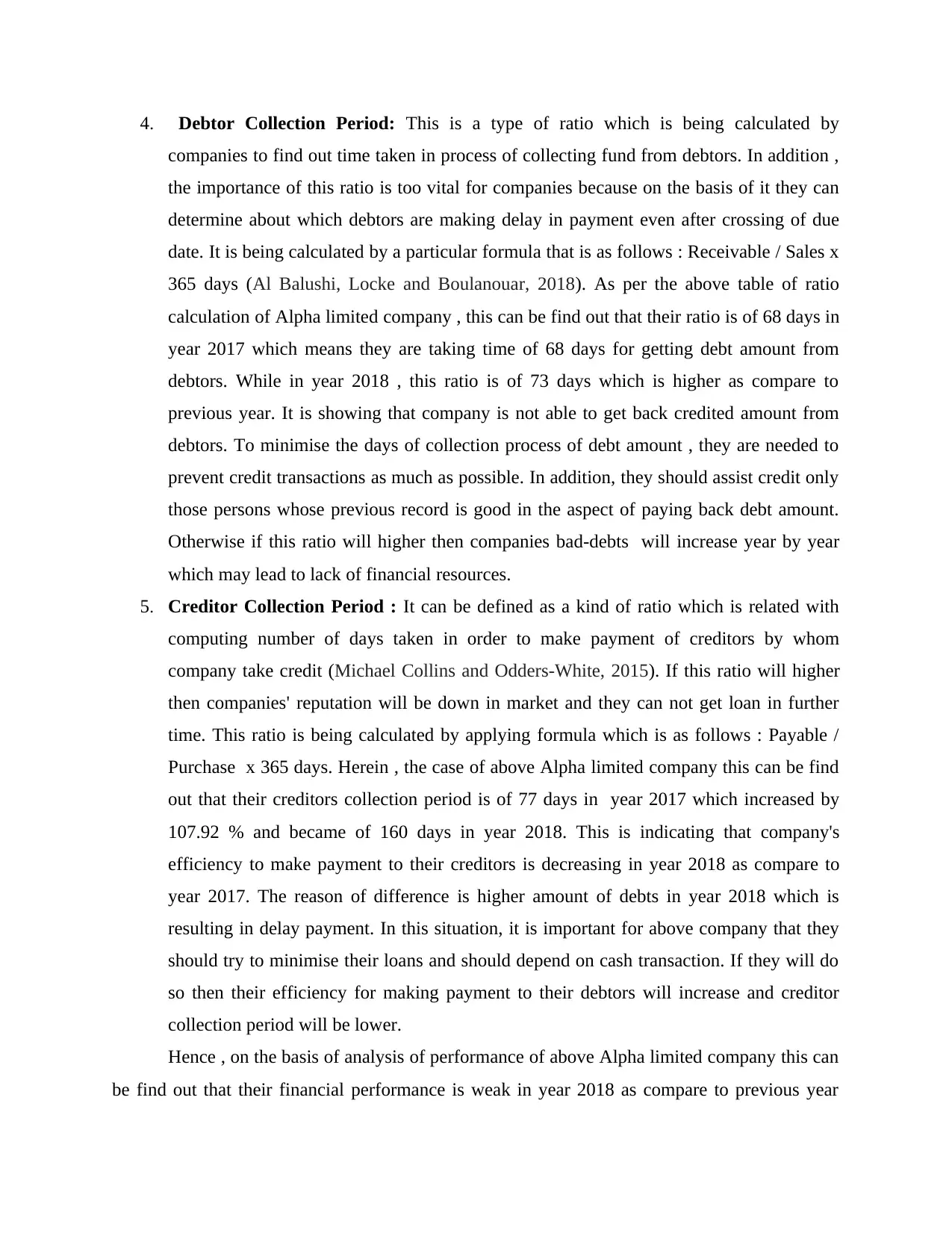
4. Debtor Collection Period: This is a type of ratio which is being calculated by
companies to find out time taken in process of collecting fund from debtors. In addition ,
the importance of this ratio is too vital for companies because on the basis of it they can
determine about which debtors are making delay in payment even after crossing of due
date. It is being calculated by a particular formula that is as follows : Receivable / Sales x
365 days (Al Balushi, Locke and Boulanouar, 2018). As per the above table of ratio
calculation of Alpha limited company , this can be find out that their ratio is of 68 days in
year 2017 which means they are taking time of 68 days for getting debt amount from
debtors. While in year 2018 , this ratio is of 73 days which is higher as compare to
previous year. It is showing that company is not able to get back credited amount from
debtors. To minimise the days of collection process of debt amount , they are needed to
prevent credit transactions as much as possible. In addition, they should assist credit only
those persons whose previous record is good in the aspect of paying back debt amount.
Otherwise if this ratio will higher then companies bad-debts will increase year by year
which may lead to lack of financial resources.
5. Creditor Collection Period : It can be defined as a kind of ratio which is related with
computing number of days taken in order to make payment of creditors by whom
company take credit (Michael Collins and Odders-White, 2015). If this ratio will higher
then companies' reputation will be down in market and they can not get loan in further
time. This ratio is being calculated by applying formula which is as follows : Payable /
Purchase x 365 days. Herein , the case of above Alpha limited company this can be find
out that their creditors collection period is of 77 days in year 2017 which increased by
107.92 % and became of 160 days in year 2018. This is indicating that company's
efficiency to make payment to their creditors is decreasing in year 2018 as compare to
year 2017. The reason of difference is higher amount of debts in year 2018 which is
resulting in delay payment. In this situation, it is important for above company that they
should try to minimise their loans and should depend on cash transaction. If they will do
so then their efficiency for making payment to their debtors will increase and creditor
collection period will be lower.
Hence , on the basis of analysis of performance of above Alpha limited company this can
be find out that their financial performance is weak in year 2018 as compare to previous year
companies to find out time taken in process of collecting fund from debtors. In addition ,
the importance of this ratio is too vital for companies because on the basis of it they can
determine about which debtors are making delay in payment even after crossing of due
date. It is being calculated by a particular formula that is as follows : Receivable / Sales x
365 days (Al Balushi, Locke and Boulanouar, 2018). As per the above table of ratio
calculation of Alpha limited company , this can be find out that their ratio is of 68 days in
year 2017 which means they are taking time of 68 days for getting debt amount from
debtors. While in year 2018 , this ratio is of 73 days which is higher as compare to
previous year. It is showing that company is not able to get back credited amount from
debtors. To minimise the days of collection process of debt amount , they are needed to
prevent credit transactions as much as possible. In addition, they should assist credit only
those persons whose previous record is good in the aspect of paying back debt amount.
Otherwise if this ratio will higher then companies bad-debts will increase year by year
which may lead to lack of financial resources.
5. Creditor Collection Period : It can be defined as a kind of ratio which is related with
computing number of days taken in order to make payment of creditors by whom
company take credit (Michael Collins and Odders-White, 2015). If this ratio will higher
then companies' reputation will be down in market and they can not get loan in further
time. This ratio is being calculated by applying formula which is as follows : Payable /
Purchase x 365 days. Herein , the case of above Alpha limited company this can be find
out that their creditors collection period is of 77 days in year 2017 which increased by
107.92 % and became of 160 days in year 2018. This is indicating that company's
efficiency to make payment to their creditors is decreasing in year 2018 as compare to
year 2017. The reason of difference is higher amount of debts in year 2018 which is
resulting in delay payment. In this situation, it is important for above company that they
should try to minimise their loans and should depend on cash transaction. If they will do
so then their efficiency for making payment to their debtors will increase and creditor
collection period will be lower.
Hence , on the basis of analysis of performance of above Alpha limited company this can
be find out that their financial performance is weak in year 2018 as compare to previous year
⊘ This is a preview!⊘
Do you want full access?
Subscribe today to unlock all pages.

Trusted by 1+ million students worldwide
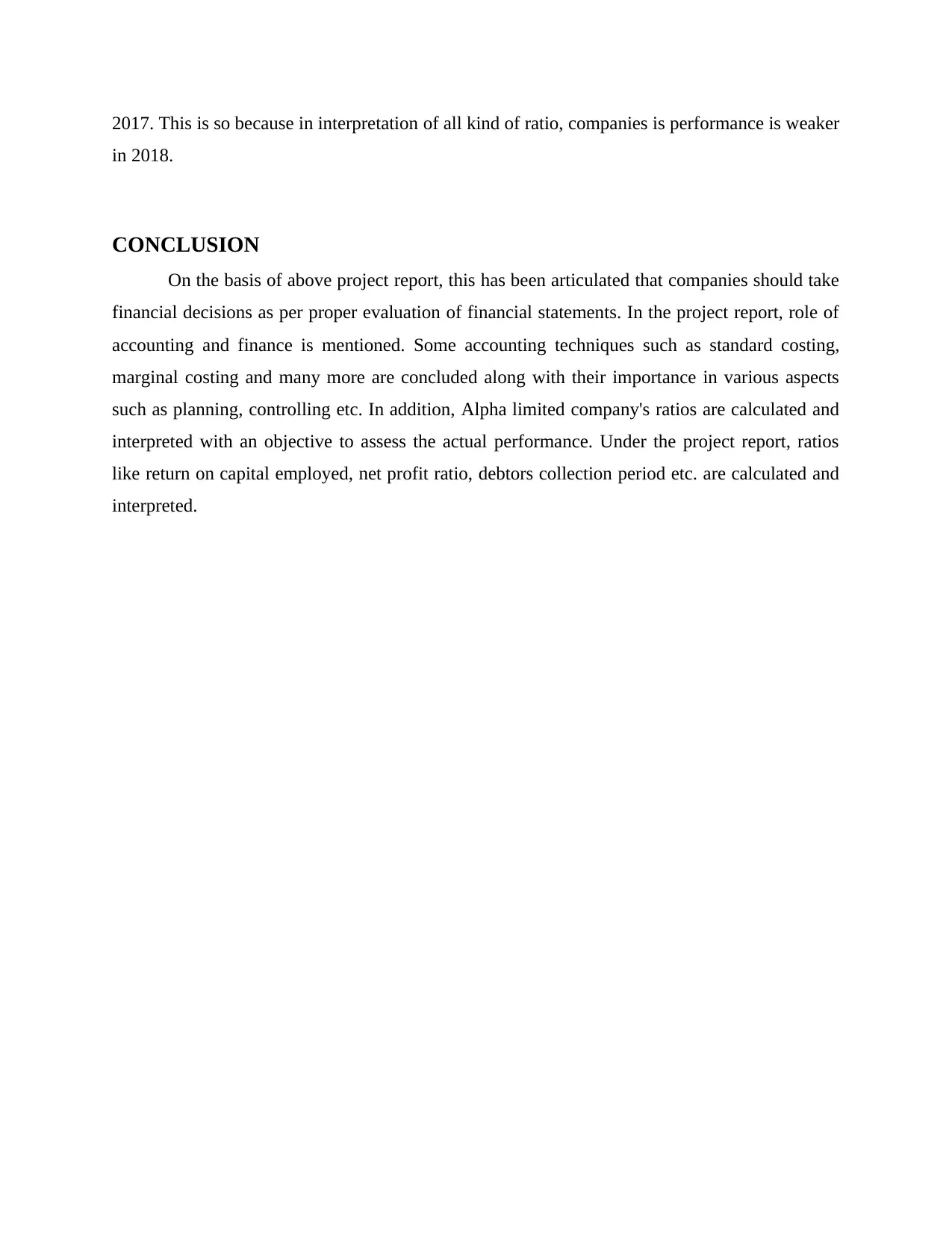
2017. This is so because in interpretation of all kind of ratio, companies is performance is weaker
in 2018.
CONCLUSION
On the basis of above project report, this has been articulated that companies should take
financial decisions as per proper evaluation of financial statements. In the project report, role of
accounting and finance is mentioned. Some accounting techniques such as standard costing,
marginal costing and many more are concluded along with their importance in various aspects
such as planning, controlling etc. In addition, Alpha limited company's ratios are calculated and
interpreted with an objective to assess the actual performance. Under the project report, ratios
like return on capital employed, net profit ratio, debtors collection period etc. are calculated and
interpreted.
in 2018.
CONCLUSION
On the basis of above project report, this has been articulated that companies should take
financial decisions as per proper evaluation of financial statements. In the project report, role of
accounting and finance is mentioned. Some accounting techniques such as standard costing,
marginal costing and many more are concluded along with their importance in various aspects
such as planning, controlling etc. In addition, Alpha limited company's ratios are calculated and
interpreted with an objective to assess the actual performance. Under the project report, ratios
like return on capital employed, net profit ratio, debtors collection period etc. are calculated and
interpreted.
Paraphrase This Document
Need a fresh take? Get an instant paraphrase of this document with our AI Paraphraser
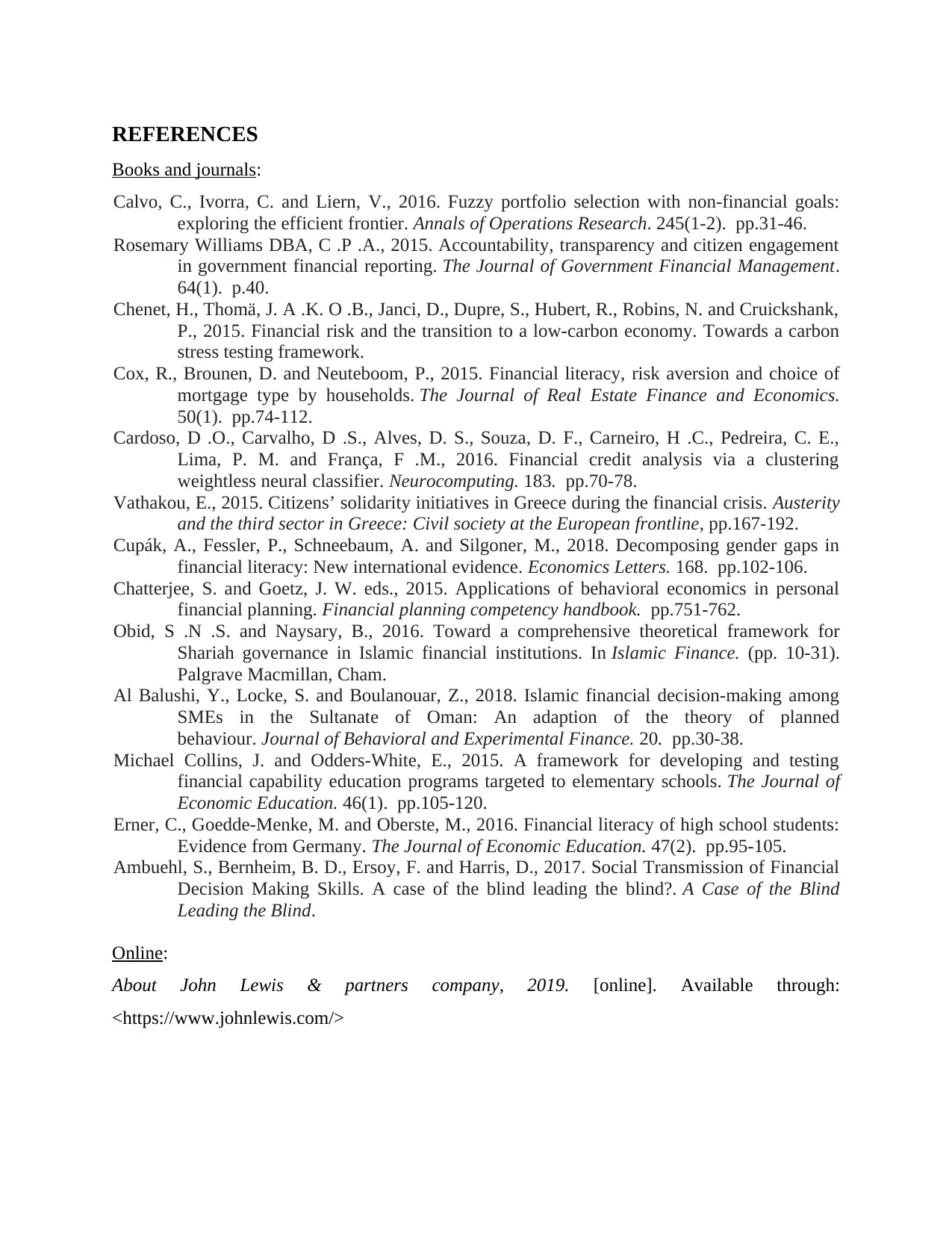
REFERENCES
Books and journals:
Calvo, C., Ivorra, C. and Liern, V., 2016. Fuzzy portfolio selection with non-financial goals:
exploring the efficient frontier. Annals of Operations Research. 245(1-2). pp.31-46.
Rosemary Williams DBA, C .P .A., 2015. Accountability, transparency and citizen engagement
in government financial reporting. The Journal of Government Financial Management.
64(1). p.40.
Chenet, H., Thomä, J. A .K. O .B., Janci, D., Dupre, S., Hubert, R., Robins, N. and Cruickshank,
P., 2015. Financial risk and the transition to a low-carbon economy. Towards a carbon
stress testing framework.
Cox, R., Brounen, D. and Neuteboom, P., 2015. Financial literacy, risk aversion and choice of
mortgage type by households. The Journal of Real Estate Finance and Economics.
50(1). pp.74-112.
Cardoso, D .O., Carvalho, D .S., Alves, D. S., Souza, D. F., Carneiro, H .C., Pedreira, C. E.,
Lima, P. M. and França, F .M., 2016. Financial credit analysis via a clustering
weightless neural classifier. Neurocomputing. 183. pp.70-78.
Vathakou, E., 2015. Citizens’ solidarity initiatives in Greece during the financial crisis. Austerity
and the third sector in Greece: Civil society at the European frontline, pp.167-192.
Cupák, A., Fessler, P., Schneebaum, A. and Silgoner, M., 2018. Decomposing gender gaps in
financial literacy: New international evidence. Economics Letters. 168. pp.102-106.
Chatterjee, S. and Goetz, J. W. eds., 2015. Applications of behavioral economics in personal
financial planning. Financial planning competency handbook. pp.751-762.
Obid, S .N .S. and Naysary, B., 2016. Toward a comprehensive theoretical framework for
Shariah governance in Islamic financial institutions. In Islamic Finance. (pp. 10-31).
Palgrave Macmillan, Cham.
Al Balushi, Y., Locke, S. and Boulanouar, Z., 2018. Islamic financial decision-making among
SMEs in the Sultanate of Oman: An adaption of the theory of planned
behaviour. Journal of Behavioral and Experimental Finance. 20. pp.30-38.
Michael Collins, J. and Odders-White, E., 2015. A framework for developing and testing
financial capability education programs targeted to elementary schools. The Journal of
Economic Education. 46(1). pp.105-120.
Erner, C., Goedde-Menke, M. and Oberste, M., 2016. Financial literacy of high school students:
Evidence from Germany. The Journal of Economic Education. 47(2). pp.95-105.
Ambuehl, S., Bernheim, B. D., Ersoy, F. and Harris, D., 2017. Social Transmission of Financial
Decision Making Skills. A case of the blind leading the blind?. A Case of the Blind
Leading the Blind.
Online:
About John Lewis & partners company, 2019. [online]. Available through:
<https://www.johnlewis.com/>
Books and journals:
Calvo, C., Ivorra, C. and Liern, V., 2016. Fuzzy portfolio selection with non-financial goals:
exploring the efficient frontier. Annals of Operations Research. 245(1-2). pp.31-46.
Rosemary Williams DBA, C .P .A., 2015. Accountability, transparency and citizen engagement
in government financial reporting. The Journal of Government Financial Management.
64(1). p.40.
Chenet, H., Thomä, J. A .K. O .B., Janci, D., Dupre, S., Hubert, R., Robins, N. and Cruickshank,
P., 2015. Financial risk and the transition to a low-carbon economy. Towards a carbon
stress testing framework.
Cox, R., Brounen, D. and Neuteboom, P., 2015. Financial literacy, risk aversion and choice of
mortgage type by households. The Journal of Real Estate Finance and Economics.
50(1). pp.74-112.
Cardoso, D .O., Carvalho, D .S., Alves, D. S., Souza, D. F., Carneiro, H .C., Pedreira, C. E.,
Lima, P. M. and França, F .M., 2016. Financial credit analysis via a clustering
weightless neural classifier. Neurocomputing. 183. pp.70-78.
Vathakou, E., 2015. Citizens’ solidarity initiatives in Greece during the financial crisis. Austerity
and the third sector in Greece: Civil society at the European frontline, pp.167-192.
Cupák, A., Fessler, P., Schneebaum, A. and Silgoner, M., 2018. Decomposing gender gaps in
financial literacy: New international evidence. Economics Letters. 168. pp.102-106.
Chatterjee, S. and Goetz, J. W. eds., 2015. Applications of behavioral economics in personal
financial planning. Financial planning competency handbook. pp.751-762.
Obid, S .N .S. and Naysary, B., 2016. Toward a comprehensive theoretical framework for
Shariah governance in Islamic financial institutions. In Islamic Finance. (pp. 10-31).
Palgrave Macmillan, Cham.
Al Balushi, Y., Locke, S. and Boulanouar, Z., 2018. Islamic financial decision-making among
SMEs in the Sultanate of Oman: An adaption of the theory of planned
behaviour. Journal of Behavioral and Experimental Finance. 20. pp.30-38.
Michael Collins, J. and Odders-White, E., 2015. A framework for developing and testing
financial capability education programs targeted to elementary schools. The Journal of
Economic Education. 46(1). pp.105-120.
Erner, C., Goedde-Menke, M. and Oberste, M., 2016. Financial literacy of high school students:
Evidence from Germany. The Journal of Economic Education. 47(2). pp.95-105.
Ambuehl, S., Bernheim, B. D., Ersoy, F. and Harris, D., 2017. Social Transmission of Financial
Decision Making Skills. A case of the blind leading the blind?. A Case of the Blind
Leading the Blind.
Online:
About John Lewis & partners company, 2019. [online]. Available through:
<https://www.johnlewis.com/>
1 out of 11
Related Documents
Your All-in-One AI-Powered Toolkit for Academic Success.
+13062052269
info@desklib.com
Available 24*7 on WhatsApp / Email
![[object Object]](/_next/static/media/star-bottom.7253800d.svg)
Unlock your academic potential
Copyright © 2020–2025 A2Z Services. All Rights Reserved. Developed and managed by ZUCOL.





